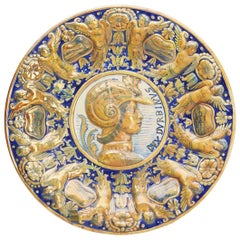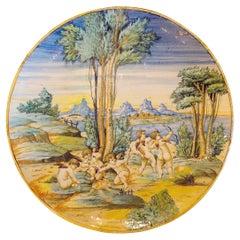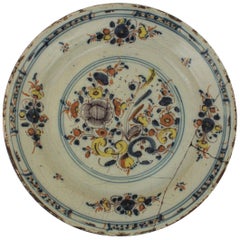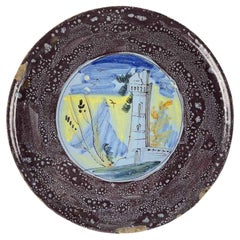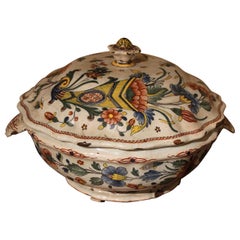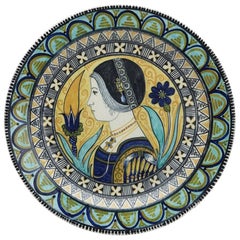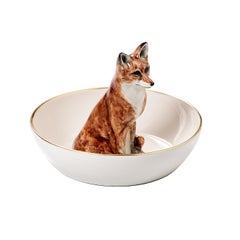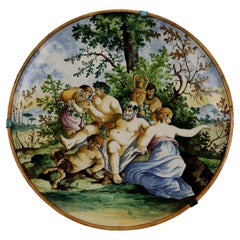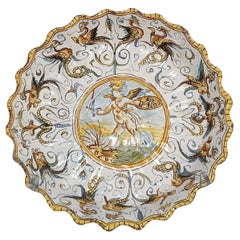Maiolica Bowls and Baskets
to
2
10
1
6
4
1
4
1
1
154
5,945
4,497
3,892
2,217
10
1
11
8
1
1
Height
to
Width
to
11
10
10
2
1
1
Material: Maiolica
Antique Continental Maiolica Moulded Lustre Figural Wall Plaque / Dish
Located in Bishop's Stortford, Hertfordshire
A superb antique relief moulded Continental Maiolica dish or plaque relief moulded with a side profile portrait of a figure wearing a military helmet and with the words DUX D'URBINUS...
Category
19th Century European Antique Maiolica Bowls and Baskets
Materials
Earthenware, Maiolica
19th century Large Maiolica Tin-Glazed Wall Plate with Frolicking Cherubim
Located in Leesburg, VA
19th century Large Maiolica Tin-Glazed Wall Plate with Frolicking Cherubim
Probably Cantagalli family workshop
Florence, Italy; 19th century
Tin-glazed baked clay
Approximate size:...
Category
Late 19th Century Italian Renaissance Antique Maiolica Bowls and Baskets
Materials
Ceramic, Maiolica
Spanish 17th Century Ceramic Circular Charger Plate, Talavera or Puente
Located in Barcelona, ES
Spanish Faience charger with floral motifs. Talavera de la Reina-Puente del Arzobispo, Toledo. Spain, late 17th century.
Hand painted in ochre, yellow, brown and blue with a central...
Category
Late 17th Century Spanish Antique Maiolica Bowls and Baskets
Materials
Ceramic, Earthenware, Faience, Maiolica
18th Century Italian Berrettino Majolica Faience Riser
Located in Milano, MI
An Italian maiolica berrettino-ground riser from 18th century, central Italy, probably Faenza origin. In the central part of the riser a ruined tower is painted within a mountain lan...
Category
Mid-18th Century Italian Rococo Antique Maiolica Bowls and Baskets
Materials
Maiolica
Antique French Faience Lidded Bowl Tureen Hand Painted with Flowers and Insects
By Rouen
Located in Firenze, IT
A French 18th century large polychrome Faience lidded soup toureen or entree dish with scallop-shaped edges attributable to Rouen manufacture.
This lovely...
Category
18th Century French Rococo Antique Maiolica Bowls and Baskets
Materials
Maiolica, Porcelain, Pottery, Faience
Torquato Castellani Majolica Renaissance Revival Tin-Glazed Charger
Located in Bishop's Stortford, Hertfordshire
An exceptional Renaissance Revival Maiolica tin-glazed plate painted with a side profile portrait of a lady within a decorative border with a line painted design to the base. The lig...
Category
1880s Italian Renaissance Revival Antique Maiolica Bowls and Baskets
Materials
Earthenware, Maiolica
Italian Maiolica Ancient Sugar Bowl, Lodi, 1770-1780
Located in Milano, IT
Maiolica sugar bowl
Antonio Ferretti Manufacture
Lodi, Circa 1770-1780
Maiolica polychrome decorated “a piccolo fuoco” (third fire).
It measures 3.54 x 4.52 x 3.54 in (9 x 11,5 x 9 cm)
Weight: 0.394 lb (0.179 kg)
State of conservation: small and slight chips on the edges.
The small sugar bowl has a swollen and ribbed body resting on a flat base. The cap-shaped lid follows the rib of the container and is topped with a small knob in the shape of a two-colored fruit.
The sugar bowl is painted “a piccolo fuoco” (third fire) with the characteristic floral motif of bunches and isolated semis.
An example which closely corresponds to this one is kept at the Civic Museum in Lodi (G. Gregorietti, Maioliche di Lodi, Milano e Pavia, Catalogo della Mostra, Milano, 1964 n. 137).
This decorative style represented a strong point of the Lodi factory, which established itself thanks to the vivid nature of the colors made possible by the introduction of a new technique perfected by Paul Hannong in Strasbourg and later introduced by Antonio Ferretti to Italy. The production process, called “piccolo fuoco” (third fire), allowed the use of a greater number of colors than in the past; in particular, the purple of Cassius, a red made from gold chloride, was introduced. Its use allowed for many more tones and shades, from pink to purple.
The Ferretti family started their maiolica manufacturing business in Lodi in 1725.
The forefather Simpliciano started the business by purchasing an ancient furnace in 1725 and, indeed, we have evidence of the full activity of the furnaces starting from April of the same year (Novasconi-Ferrari-Corvi, 1964, p. 26 n. 4). Simpliciano started a production of excellence also thanks to the ownership of clay quarries in Stradella, not far from Pavia. The production was so successful that in 1726 a decree of the Turin Chamber came to prohibit the importation of foreign ceramics, especially from Lodi, to protect internal production (G. Lise, La ceramica a Lodi, Lodi 1981, p. 59).
In its initial stages, the manufacture produced maolicas painted with the “a gran fuoco” (double fire) technique, often in turquoise monochrome, with ornamentation derived from compositional modules in vogue in Rouen in France. This was also thanks to the collaboration of painters like Giorgio Giacinto Rossetti, who placed his name on the best specimens next to the initials of the factory.
In 1748 Simpliciano made his will (Gelmini, 1995, p. 30) appointing his son Giuseppe Antonio (known as Antonio) as universal heir. After 1750, when Simpliciano passed away, Antonio was directly involved in the maiolica factory, increasing its fortunes and achieving a reputation on a European level. Particularly important was the aforementioned introduction in 1760 of the innovative “a piccolo fuoco” (third fire) processing, which, expanding the ornamental repertoire with Saxon-inspired floral themes, was able to commercially compete with the German porcelains that had one of its most renowned offerings in the naturalistic Deutsche Blumen. Antonio Ferretti understood and promoted this technique and this decoration, proposing it in a fresher and more corrective version, less linked to botanical tables, both with or without contour lines, as well as in purple or green monochrome. After efforts to introduce more industrial production techniques to the sector succeeded, even the Ferretti manufacture, in the last decade of the eighteenth century, started heading towards decline despite its attempts to adapt production to neoclassical tastes.
In 1796 the Napoleonic battle for the conquest of the Lodi bridge over the Adda definitively compromised the furnaces. Production resumed, albeit in a rather stunted manner, until Antonio's death on 29 December 1810. (M. L. Gelmini, pp. 28-30, 38, 43 sgg., 130-136 (for Simpliciano); pp. 31 sgg., 45-47, 142-192 (for Antonio).
Bibliography
G. Gregorietti, Maioliche di Lodi Milano e Pavia Catalogo della Mostra, Milano, 1964 n. 137;
C. Baroni, Storia delle ceramiche nel Lodigiano, in Archivio storico per la città e i comuni del circondario e della diocesi di Lodi, XXXIV (1915), pp. 118, 124, 142; XXXV (1916), pp. 5-8;
C. Baroni, La maiolica antica di Lodi, in Archivio storico lombardo, LVIII (1931), pp. 453-455;
L. Ciboldi, La maiolica lodigiana, in Archivio storico lodigiano, LXXX (1953), pp. 25 sgg.;
S. Levy, Maioliche settecentesche lombarde e venete, Milano 1962, pp. 17 sgg.;
A. Novasconi - S. Ferrari - S. Corvi, La ceramica lodigiana, Lodi 1964, ad Indicem; Maioliche di Lodi, Milano e Pavia (catal.), Milano 1964, p. 17;
O. Ferrari - G. Scavizzi, Maioliche italiane del Seicento e del Settecento, Milano 1965, pp. 26 sgg.;
G. C. Sciolla, Lodi. Museo civico, Bologna 1977, pp. 69-85 passim; G. Lise, La ceramica a Lodi, Lodi 1981;
M. Vitali, in Storia dell'arte ceramica...
Category
1770s Italian Rococo Antique Maiolica Bowls and Baskets
Materials
Maiolica
18th Century Italian Majolica Faience Centerpiece Large Lodi Circular Bowl
Located in Milano, MI
18th century Italian collectible antique painted majolica bowl, a large basin-shaped centerpiece, with vertical ribs, decorated with polychrome flowers. Small chips, felure and minor...
Category
Mid-18th Century Italian Rococo Antique Maiolica Bowls and Baskets
Materials
Maiolica
Diana and Endymion Parade Dish Castelli Manufacture Italy Late 19th century
By Castelli
Located in Milano, IT
Castelli manufacture polychrome majolica parade plate with a scene historiated with mythological subjects Diana and Endymion.
Category
1880s Italian Other Antique Maiolica Bowls and Baskets
Materials
Maiolica
$845 Sale Price
20% Off
Two Pairs of Italian Maiolica Baskets, circa 1780
Located in Milano, IT
Two pairs of maiolica baskets
Antonio Ferretti Manufacture
Lodi, circa 1770-1790
Maiolica polychrome decorated “a piccolo fuoco” (third fire).
Measures: A) Height 3.54 x 6.69 x 9.84 in (9 x 17 x 25 cm);
B) Height 3.93 x 7.48 x 11.02 in (10 x 19 x 28 cm).
Total weight 4.85 lb (2.200 kg)
State of conservation:
A) One of the smaller baskets has some areas of restoration, the other slight chipping from use;
B) One of the larger baskets is intact and the other shows a clearly glued break.
The mold with which the baskets were forged simulates a wicker weave.
The two larger works have high, vertical walls, with branch-shaped handles penetrating the weave. The painted decorations, small polychrome flowers applied only externally, highlight the points where the weaves intersect.
The decision to leave the center of the basket devoid of decoration is highly unusual, but given the size and complexity of the shape, as well as the quality of the enamel, it is possible to hypothesize that it represents a precise choice in manufacturing or for a particular client.
The two smaller baskets have small, twisted handles and, on the outside, reproduce more decisively the characteristic wicker weave, obtained through thin molded lines. The interior exhibits a rich, typical decoration of naturalistic flowers: a bunch centered around a main flower and secondary stems accompanied by small “semis”. The exterior of these works is also adorned with small little flowers where the weaves intersect.
The size and morphological characteristics of the baskets confirm their attribution to the Lodi factory of Antonio Ferretti between 1770 and 1790, during its most successful period; by this point his original reworking of the "Strasbourg" decoration, known as "old Lodi", had achieved great fame even outside Italy.
This decorative choice represented a strong point of the Lodi factory, which established itself thanks to the vivid nature of the colors made possible by the introduction of a new technique perfected by Paul Hannong in Strasbourg and which Antonio Ferretti introduced in Italy. This production process, called “piccolo fuoco” (third fire), allowed the use of a greater number of colors than in the past; in particular, the purple of Cassius, a red made from gold chloride, was introduced. Its use allowed for many more tones and shades, from pink to purple.
The Ferretti family had started their maiolica manufacturing business in Lodi in 1725.
The forefather Simpliciano had started the business by purchasing an ancient furnace in 1725 and, indeed, we have evidence of the full activity of the furnaces from April of the same year (Novasconi-Ferrari-Corvi, 1964, p. 26 n. 4). Simpliciano had started a production of excellence also thanks to the ownership of clay quarries in Stradella, not far from Pavia. The production was so successful that in 1726 a decree of the Turin Chamber came to prohibit the importation of foreign ceramics, especially from Lodi, to protect internal production (G. Lise, La ceramica a Lodi, Lodi 1981, p. 59).
In its initial stages, the manufacture produced maolicas painted with the “a gran fuoco” (double fire) technique, often in turquoise monochrome, with ornamentation derived from compositional modules in vogue in Rouen in France. This was also thanks to the collaboration of painters like Giorgio Giacinto Rossetti, who placed his name on the best specimens next to the initials of the factory.
In 1748 Simpliciano made his will (Gelmini, 1995, p. 30) appointing his son Giuseppe Antonio (known as Antonio) as universal heir. After 1750, when Simpliciano passed away, Antonio was directly involved in the maiolica factory, increasing its fortunes and achieving a reputation on a European level. Particularly important was the aforementioned introduction in 1760 of the innovative “a piccolo fuoco” (third fire) processing, which, expanding the ornamental repertoire with Saxon-inspired floral themes, could commercially compete with the German porcelains that had one of its most renowned offerings in the naturalistic Deutsche Blumen. Antonio Ferretti understood and promoted this technique and this decoration, proposing it in a fresher and more corrective version, less linked to botanical tables...
Category
1770s Italian Neoclassical Antique Maiolica Bowls and Baskets
Materials
Maiolica
Apollineo Arena Centerpiece in Leccese Stone and Hand-Painted Maiolica
By TIPSTUDIO
Located in Florence, IT
The Apollineo collection mergs classical and contemporary elements to define a unique aesthetic inspired by Mediterranean architecture and vibes. Sun-blessed pure volumes, shapes mar...
Category
2010s Italian Modern Maiolica Bowls and Baskets
Materials
Stone, Limestone
$679 Sale Price
28% Off
Related Items
Porcelain Bowl with Fox Figure Sofina Boutique Kitzbuehel
Located in Kitzbühel, Tirol
Completely handmade porcelain bowl with a hands-free naturalistic painted fox in brown colors. The fox is sitting in the middle of the bowl for decorating nuts or sweets around the fox figure...
Category
2010s German Black Forest Maiolica Bowls and Baskets
Materials
Porcelain
Vintage French Ceramic Dish
Located in High Point, NC
This vintage ceramic decoration offers an attractive accent. Made in France in the 20th century, the flowing curves of the scalloped edges create an attractive form, reminiscent of a...
Category
20th Century French Maiolica Bowls and Baskets
Materials
Ceramic
Travertine Bowl With Lid
Located in Eindhoven, NB
Stunning, aesthetic, timeless are words that can be used to describe this elegant and modern travertine bowl from Kiwano. Expertly crafted and finished by hand, our travertine vases ...
Category
2010s Dutch Modern Maiolica Bowls and Baskets
Materials
Marble
19th Century French Tian Bowl with Yellow Glaze
Located in Atlanta, GA
This 19th-century French Tian bowl is a classic example of rustic Provençal pottery, once an essential kitchen vessel in southern France. Handcrafted ...
Category
19th Century French Antique Maiolica Bowls and Baskets
Materials
Terracotta
Large Midcentury French Mosaic Ceramic Bowl Gerbino Vallauris
Located in Austin, TX
Large midcentury French Mosaic Ceramic Bowl Gerbino Vallauris.
Diameter / 12 inches.
Category
1950s French Mid-Century Modern Vintage Maiolica Bowls and Baskets
Materials
Ceramic, Faience
$760 Sale Price
20% Off
H 3.7 in Dm 12 in
19th Century Large Pantry Box with Lid
Located in Los Angeles, CA
19th century pantry box with lid in good condition. Found in New England in good condition.
Category
19th Century American Adirondack Antique Maiolica Bowls and Baskets
Materials
Wood
Antique Victorian Historism Majolica Pedestal Bowl / Centerpiece Knights Dragons
Located in Bad Säckingen, DE
This antique Historism centerpiece / pedestal bowl is made of polychrom glazed majolica and features four cartouches decorated with high relief knight helmets and dragons. The manufa...
Category
1880s German Rococo Revival Antique Maiolica Bowls and Baskets
Materials
Ceramic, Majolica
$655 Sale Price
20% Off
H 5.52 in W 11.03 in D 11.03 in
Vintage Moser Gilt Glass Bowl with Green Cabochons
By Moser
Located in Philadelphia, PA
A fine vintage Bohemian art glass bowl.
With large green cabochons around its circumference and rich gilt decoration.
Attributed to Moser.
...
Category
20th Century Czech Maiolica Bowls and Baskets
Materials
Glass
Set of 7 Miniature Wedgwood Lustre Bowls by Daisy Makeig-Jones
Located in Fort Lauderdale, FL
A set of 7 miniature blue and orange lustre bowl designed by Daisy Makeig-Jones for Wedgwood ca. 1920 and decorated with the 'Hummingbirds' pattern.
Daisy Makeig-Jones’s lustreware ...
Category
1920s English Art Nouveau Vintage Maiolica Bowls and Baskets
Materials
Ceramic, Luster, Porcelain
19th Century Spanish Glazed Clay Pot with Lovely Old Mend
Located in Atlanta, GA
A Spanish clay pot with spout from the 19th century. This antique round-shaped vessel from Spain is wider towards it's top and mid-section, becoming m...
Category
19th Century Spanish Antique Maiolica Bowls and Baskets
Materials
Clay
18th Century Spanish, Hand-Painted Glazed Ceramic Plate from Triana
Located in Marbella, ES
18th Century Spanish hand-painted glazed ceramic plate from Triana.
Category
18th Century Spanish Antique Maiolica Bowls and Baskets
Materials
Ceramic
Late 17th-Early 18th Century Italian Majolica Bowl
Located in Hudson, NY
This good sized bowl is a great example of the majolica wares produced in Italy throughout the 15th, 16th, 17, and 18th centuries. Humble and simple but highly decorative and enterta...
Category
Early 18th Century Italian Antique Maiolica Bowls and Baskets
Materials
Majolica
Previously Available Items
Maiolica Parade Dish Castelli Manifattura Italy Late 19th century
By Castelli
Located in Milano, IT
Castelli manufacture polychrome majolica parade plate with a scene historiated with mythological subjects.
Category
1890s Italian Other Antique Maiolica Bowls and Baskets
Materials
Maiolica
SECOND HALF OF THE 16th CENTURY POLYCHROME MAIOLICA PLATE
Located in Firenze, FI
Splendid plate in polychrome glazed majolica in yellow, blue, green and manganese. The plate has a wavy rim which gives it the name "crespina", and in the center it is adorned with t...
Category
16th Century Italian Renaissance Antique Maiolica Bowls and Baskets
Materials
Maiolica
Grande ciotola, Aldo Londi per Bitossi, anni 50
By Bitossi, Aldo Londi
Located in Firenze, IT
Bellissima e grande ciotola disegnata da Aldo Londi per Bitossi, di cui era direttore artistico, nei primi anni 50. È modellato con terra refrattaria nei toni del marrone con un deco...
Category
1950s Italian Mid-Century Modern Vintage Maiolica Bowls and Baskets
Materials
Ceramic, Maiolica
16th Century Italian Maiolica Faience Dish with a Young Man Portrait
Located in Milano, MI
Mid-16th Century Italian Maiolica Dish hand-painted in blue and ocher yellow color with a profile young man portrait in the center. The maiolica col...
Category
16th Century Italian Renaissance Antique Maiolica Bowls and Baskets
Materials
Maiolica
Large Antique Italian 18th Century Maiolica Faience Istoriato Plate Urbino 1790
By Urbino Workshop
Located in Portland, OR
A large & fine antique Italian maiolica Istoriato charger, Urbino, circa 1800.
This very handsome charger is hand-painted with Neoclassical nu...
Category
Late 18th Century Italian Baroque Antique Maiolica Bowls and Baskets
Materials
Maiolica
H 1.97 in Dm 17.03 in
Antique 19th Century Minton Majolica Centerpiece Tazza with Doves & Cherubs 1861
By Minton
Located in Portland, OR
A good antique Minton Majolica centerpiece/tazza, 1861.
The centerpiece with a flanged shaped shallow dish supported with a pair of winged cher...
Category
1860s English Victorian Antique Maiolica Bowls and Baskets
Materials
Maiolica
H 6.5 in W 11 in D 7 in
Pair of Large Italian Maiolica Chargers, Venus and Neptune, 19th Century
Located in London, GB
On offer is a wonderful pair of huge Italian maiolica chargers made in the 19th Century. The chargers are painted with lively scenes of Neptune and Venus in carriages drawn by horses...
Category
19th Century Italian Renaissance Revival Antique Maiolica Bowls and Baskets
Materials
Maiolica
Set of 12 Decorative Green Midcentury Ceramic Handmade Plates
Located in Queretaro, Queretaro
This Majolica pottery plate collection was designed by Mexican sculptor, painter, and ceramist Lorenzo Lorenzzo made in his studio, in the colon...
Category
21st Century and Contemporary Mexican Mid-Century Modern Maiolica Bowls and Baskets
Materials
Ceramic, Clay, Maiolica, Majolica
Recently Viewed
View AllMore Ways To Browse
Axel Sorensen
Carlo Scarpa Murrine
Sevres Cristal
Antique Grape Hod
Esart Italy
Lustre Ware
Antique German Decor
Bronce Denmark
French Copper Kettle
Desimone Hand Painted Art Pottery
Veritas Glass
Jasperware Basalt
Karin Bjorquist
Metal Bucket Fire
Painted Wastebasket
Rattan Fruit Basket
United Metal Trash Can
Vintage French Wire Baskets
